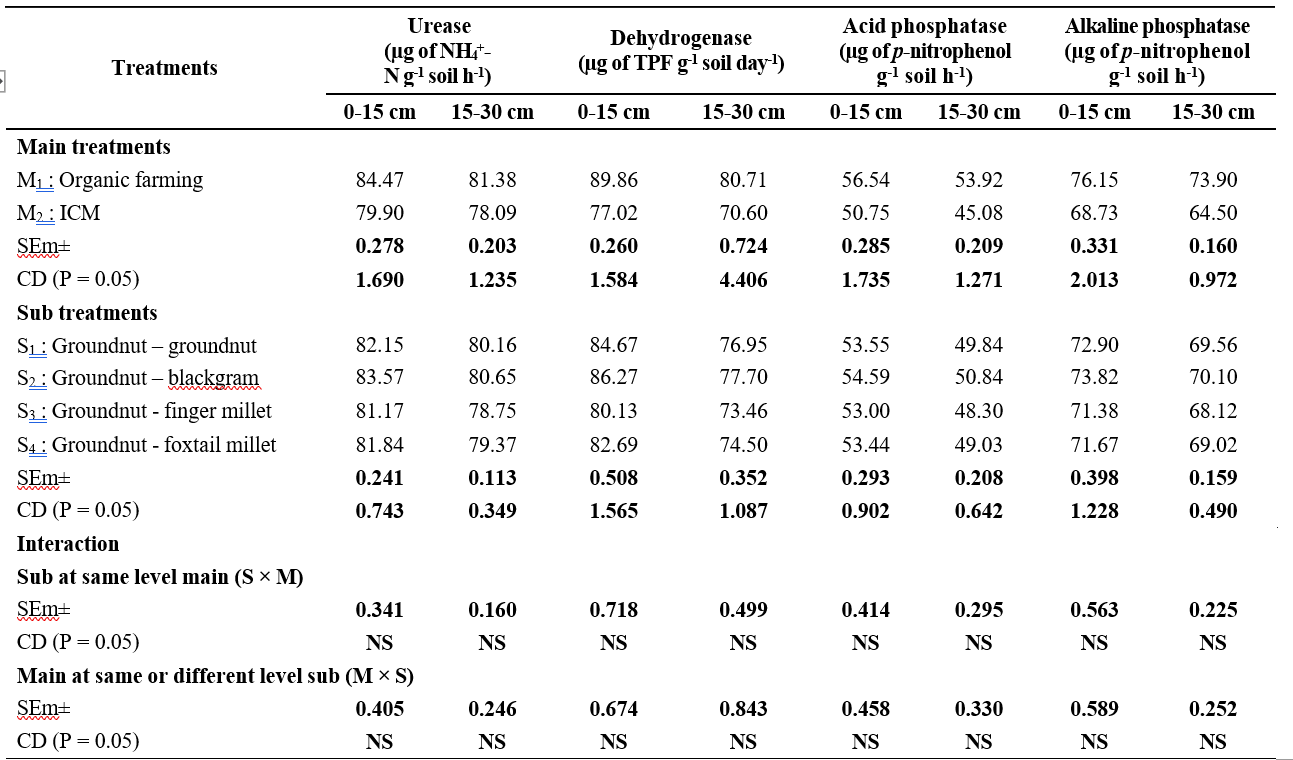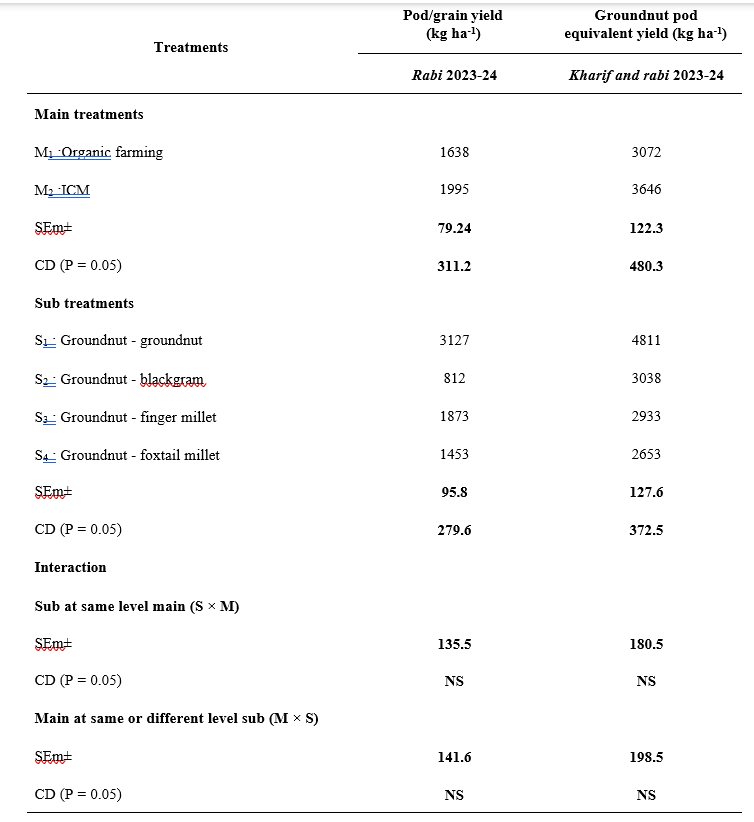Effect of Organic Farming on Soil Enzymatic Activity and Productivity of Groundnut Based Cropping System
0 Views
HEMALATHA*, M. MADHAN MOHAN, C.H. BHARGAVA RAMI REDDY AND SUNITHA
Department of Soil Science, S.V. Agricultural College, ANGRAU, Tirupati-517 502.
ABSTRACT
A field experiment was conducted at Regional Agricultural Research Station, Tirupati on groundnut based cropping systems during kharif and rabi 2023-24 under organic and ICM practices. Soil samples were collected at 0-15 and 15-30 cm and analysed for enzymatic activity. The higher urease activity (84.47 and 81.38 µg of NH +-N g-1 soil h-1), dehydrogenase activity (89.86 and 80.71 μg of TPF g-1 soil day-1), acid phosphatase activity (56.54 and 53.92 µg of NH +-N g-1 soil h-1) and alkaline phosphatase activity (76.15 and 73.90 µg of p-nitrophenol g-1 soil h-1) were noticed in organic farming (M1) compared to ICM practice (M2) at 0-15 and 15-30 cm, respectively. During kharif season, the higher mean pod (1813 kg ha-1) and haulm yield (3085 kg ha-1) were recorded in ICM practice compared to organic farming. Similarly, during rabi 2023-24, the higher mean pod /grain yield and groundnut pod equivalent yield was recorded in ICM practice (1995 kg ha-1 and 3646 kg ha-1) compared to organic farming. Among the groundnut based cropping systems adopted in the present study, the higher and lower pod yields (3127 kg ha-1 and 812 kg ha-1) were recorded in groundnut (S1) and blackgram (S2) crops, respectively. The higher pod equivalent yield (4811 kg ha-1) was recorded in groundnut-groundnut (S1) cropping system, followed by groundnut-blackgram (S2) (3038 kg ha-1) and whereas, the lowest was recorded in groundnut-foxtail millet (S4) cropping system (2653kg ha-1). Hence, groundnut-groundnut cropping system is superior over other cropping systems.
KEYWORDS: Cropping systems, groundnut pod equivalent yield, enzymatic activity.
INTRODUCTION
Organic agriculture is a production system that prioritizes the health of agro-ecosystems by promoting biodiversity, biological cycles, and soil activity, all achieved through agronomic, biological, and mechanical methods while avoiding synthetic inputs. organic farming has been in practice from ancient times where traditional methods intentionally excluded the use of synthetic fertilizers and pesticides. In the context of climate change, organic manure application is recognized as a climate-resilient technology that can help to sequester more carbon in the soil, enhancing its ability to mitigate the effects of climate change. Groundnut is a major oilseed crop in India, ranking first in the area and second in production after soybean.
Currently, India ranks eighth in the world in terms of organic farming area and first in terms of the number of organic producers (Willer et al., 2022). India has 4.4 million hectares of land under organic farming, with a production of 3.6 million tonnes (APEDA, 2023). Among Indian states, Madhya Pradesh ranks first in certified organic farms, followed by Rajasthan, Maharashtra, and Chhattisgarh. India’s organic product exports amounted to $708 million in 2022-23. The usage of unbalanced chemical fertilizers has resulted in a decrease in nutrient use efficiency, making fertilizer consumption uneconomical through decline in productivity per unit of fertilizer applied as well as causing negative environmental effects. Organic farming, with the use of inputs such as farmyard manure, biofertilizers, and biopesticides, plays a crucial role in optimizing soil health. It helps to mitigate the negative environmental effects associated with synthetic fertilizers and ensures the sustainability of crop production.
Farmyard manure is known for its long-lasting effects on soil productivity and is a comprehensive source of all the macro and micronutrients necessary for plant growth with nitrogen, phosphorus and potassium being the key contributors. Biofertilizers contain beneficial microorganisms that help maintain environmental health by providing essential pant nutrients, reducing soil and water contamination, improving soil fertility, and promoting biological control by suppressing phytopathogenic organisms. Incorporation of farmyard manure helps to improve soil microbial activity, which in turn helps to stabilize the production and productivity of the crops in rainfed farming situations. A millet based cropping system is common in dryland and rainfed conditions. Groundnut followed by green gram, black gram, finger millet, foxtail millet, cowpea and horse gram are beneficial double cropping systems. Due to their wide adaptability to different agroclimatic conditions and seasons, making it suitable for an efficient cropping system, the present study was carried out on effect of organic farming on soil enzymatic activity and productivity under different groundnut based cropping systems.
MATERIAL AND METHODS
A long-term field experiment at Regional Agricultural Research Station, Tirupati of Acharya N.
Ranga Agricultural University was started in the year 2016 to study the effect of organic farming practices in groundnut based cropping systems on Alfisols and the present investigation was carried out as part of the ongoing experiment during kharif and rabi 2023-24 with split plot design which is geographically situated at 13.6° N latitude and 79.3° E longitude with an altitude of 189.2 meters above mean sea level in the Southern Agro-climatic zone of Andhra Pradesh. During the kharif season, the experiment was laid into two main plots viz., M1, organic farming (10 t ha-1 FYM applied at last plough, soil application of PSB, Rhizobium, KRB and Trichoderma viridae each @ 5kg ha-1, spraying of neem oil and pheromone traps @ 20 no’s ha-1) and M2, ICM treatment with Dithane M-45, chemical weed control and need based plant protection measures) with groundnut crop as a rainfed crop. During rabi season, each main plots were divided into four sub plots viz., groundnut (S1), blackgram (S2), finger millet (S3) and foxtail millet (S4). To the organic farming sub plots, 10 t ha-1 FYM was applied at last plough, soil application of PSB, Rhizobium (for groundnut and blackgram), Azospirillum (for finger millet and foxtail millet), KRB and Trichoderma viridae each @ 5 kg ha-1, pheromone traps @ 20 no’s ha-1 and neem oil spraying was done. To the ICM subplots, RDF (20-40-50, 20-50-0, 60-30-20 and 40-20-0 of N: P2O5:
K2O kg ha-1 to groundnut, blackgram, finger millet and foxtail millet), seed treatment with Dithane M-45, chemical weed control and need based plant protection measures were taken. After harvest of the rabi crops, soil samples were collected from each sub plot at depths of 0-15 and 15-30 cm and analysed for enzymatic activity by standard procedures viz., urease (Tabatabai and Bremner 1972), dehydrogenase (Casida et al., 1964), acid phosphatase and alkaline phosphatase (Eivazi and Tabatabai 1977). The yield and yield attributes were calculated in both organic and ICM plots separately during kharif and rabi seasons. The groundnut pod equivalent yield was calculated for blackgram, finger millet and foxtail millet crops by considering yield and market price of respective crops during rabi season. Statistical analysis was conducted for the results using t-test and ANOVA with data processed in SPSS.
RESULTS AND DISCUSSION
Effect of organic farming on soil enzymatic activity
The data pertaining to soil enzymatic activity viz., urease, dehydrogenase, acid and alkaline phosphatase influenced by organic farming and ICM practice were presented in Table 1.
The organic farming treatment (M1) recorded the higher urease activity of 84.47 and 81.38 µg of NH +-N g-1 soil h-1 as compared to ICM practice (79.90 and 78.09 µg of NH + -N g-1 soil h-1) at 0-15 and 15-30 cm, respectively. Among the different groundnut based cropping systems, groundnut-blackgram (S2) cropping system showed relatively higher urease activity of 83.57 and 80.65 µg of NH +-N g-1 soil h-1 and whereas, lower urease activity was observed under groundnut-finger millet (S3) cropping system with 81.17 and 78.75 µg of NH +-N g-1 soil h-1at 0-15 and 15-30 cm, respectively. The higher urease activity in the organic farming treatment might be due to enhanced microbial activities which accelerated the breakdown of organic matter in the added FYM. The higher organic matter in farmyard manure might have provided a more favourable environment for the accumulation of enzymes in soil matrix, since soil organic constituents were thought to be important in forming stable complexes with free enzymes as reported by Bhavani et al. (2017). Similar findings were reported by Reddy et al. (2016) and Choudhary et al. (2021).
The dehydrogenase activity was significantly higher in organic farming treatment (M1) (89.86 and 80.71 μg of TPF g-1 soil day-1) as compared to ICM practice (M2) (77.02 and 70.60 μg of TPF g-1 soil day-1). Among different groundnut based cropping systems, it was recorded higher in groundnut-blackgram (S2) cropping system (86.27 and
Table 1. Effect of organic farming on soil enzymatic activity after rabi, 2023-24

Table 2. Effect of organic farming on yield and yield attributes of groundnut

77.70 μg TPF g-1 soil day-1) and whereas, the lower was recorded in groundnut-finger millet (S3) cropping system (80.13 and 73.46 μg TPF g-1 day-1) at 0-15 and 15-30 cm, respectively. In organic farming, the applied farm yard manure provides energy for soil microorganisms by acting as carbon source and apart from increased number of soil pores, which were considered important in soil- water-plant relationships and maintained good soil structure accompanied by better dehydrogenase activity in organic farming treatment compared to ICM practice. The dehydrogenase activity was significantly higher in legume-based cropping systems at all stages, which might be due to the beneficial effects of legumes such as increased leaf fall and root exudation in leguminous crops. This, in turn, enhances microbial activity by providing more substrates for microbial growth, as reported by Gupta et al. (2019).
The higher acid phosphatase activity and alkaline phosphatase activity (56.54 and 53.92 µg of p-nitrophenol g-1 soil h-1; 76.15 and 73.90 µg of p-nitrophenol g-1 soil h-1) were recorded in organic farming (M1) compared to ICM practice (50.75 and 45.08 µg of p-nitrophenol g-1 soil h-1; 68.73 and 64.50 µg of p-nitrophenol g-1 soil h-1) at 0-15 and 15-30 cm, respectively. Among different groundnut based cropping systems, groundnut- blackgram (S2) showed higher acid phosphatase activity and alkaline phosphatase activity (54.59 and 50.84 µg of p-nitrophenol g-1 soil h-1 and 73.82 and 70.10 µg of p-nitrophenol g-1 soil h-1) and whereas, the lower was recorded in groundnut-finger millet (S3) cropping system (53.00 and 48.30 µg of p-nitrophenol g-1 soil h-1; 71.38 and 68.12 µg of p-nitrophenol g-1 soil h-1) at 0-15 and 15-30 cm, respectively. The increased acid phosphatase and alkaline phosphatase activity under organic farming could be due to enhancement of enzyme function caused by interaction with decomposed organic products and organic matter. The higher enzymatic activity in the soil owing to more moisture content retained in organic treated plots for longer period creating favourable conditions for plant and microbial growth. Similar findings were also reported by Prudhvi lal et al. (2016) and Verma et al. (2020).
Effect of organic farming on yield and yield attributes
Effect of organic and ICM practices on yield and yield attributes of groundnut (kharif) and groundnut based cropping systems (rabi) were presented in Tables 2 and 3. During kharif 2023, the higher mean pod and haulm yield of 1813 and 3085 kg ha-1 were observed in ICM practice (M2) compared to organic farming (M1) treatment (1556 and 2845 kg ha-1) which was 16.5 and 8.4 per cent higher pod and haulm yields, respectively But, however, the hundred pod weight, hundred kernel weight and shelling percentage were recorded higher in organic farming (M1) (77.1 g, 55.3 g and 71.90%) compared to ICM practice (M2) (76.7 g, 53.9 g and 70.49%).The higher kernel weight of groundnut in organic farming might be due to more production and translocation of photosynthates to kernel leading to better filling of pods and improvement in kernel weight as reported by Singh et al. (2018).Similar results in organic farming were reported by Kulkarni et al. (2018) and Sunitha et al. (2023).
During rabi 2023-24, the mean pod yield/grain yield of ICM practice (M2) recorded was significantly
Table 3. Effect of organic farming on pod / grain yield in different groundnut based cropping systems during (2023-24)

higher (1995 kg ha-1) compared to organic farming (M1) treatment (1638 kg ha-1) which was 21.8 per cent higher yield compared to organic farming. The pod/grain yield was varied significantly among the groundnut based cropping systems during rabi season and higher yield was recorded in groundnut (S1) (3127 kg ha-1), followed by finger millet (S3) (1873 kg ha-1) and whereas, the lowest yield was recorded in blackgram (S2) (812 kg ha- 1). The higher pod and haulm yield in ICM treated plots might be due to better availability of major nutrients required for different crops, apart from production of phytohormones like indole acetic acid, gibberrelic acid and cytokinins which promoted growth and yield of groundnut. Similar findings were reported by Vala et al. (2018) and Kamble et al. (2018).
The groundnut pod equivalent yield for different groundnut based cropping systems were calculated and highest pod equivalent yield of 3646 kg ha-1 was recorded under ICM practice (M2), which was 18.7 per cent higher compared with organic farming (M1) (3072 kg ha-1). Among the different groundnut based cropping systems followed, the groundnut pod equivalent yield was higher in groundnut-groundnut (S1) with 4811 kg ha-1, followed by groundnut-blackgram (S2) (3038 kg ha-1) and whereas, the lowest was recorded in groundnut-foxtail millet (S4) (2653kg ha-1). Despite of its lower yield in blackgram, the pod equivalent yield was higher than foxtail millet and finger millet, which was mainly attributed to higher market price of blackgram over millet crops. Higher overall productivity in terms of GPEY of intercropping over sole cropping of groundnut has also been reported by Chaudhari et al. (2017).
The organic farming practice recorded higher soil enzymatic activities compared to ICM practice and the activities were decreased in sub-surface soil irrespective of the treatment. However, the pod/grain yield and groundnut pod equivalent yield were recorded higher in ICM practice due to the effective pest control management and increased availability of major nutrients apart from synthesis of phytohormones from inorganic fertilizers. Among the various groundnut based cropping systems, groundnut-groundnut (S1) followed by groundnut-black gram (S2) systems showed superiority in improving enzymatic activity, higher yield, net returns for sustainable soil health and productivity compared to other cropping systems under study. However, the lowest pod equivalent yields of groundnut-finger millet (S3) and groundnut-foxtail millet (S4) cropping systems
compared to groundnut-groundnut (S1) is mainly due to low yield and marketable price of foxtail millet and finger millet crops.
LITERATURE CITED
apeda.gov.in. 2022-23
Bhavani, R., Srinivas, K and Reddy, K.R. 2017. Influence of organic manures and chemical fertilizers on nutrient availability in soil. International Journal of Chemical Studies. 5(6): 1473-1477.
Chaudhari, D.T., Vekariya, P.D., Vora, V.D., Talpada, M.M and Sutaria, G.S. 2017. Enhancing productivity of groundnut based intercropping systems under rainfed conditions of Gujarat. Legume Research. 40(3): 520-525.
Choudhary, M., Singh, V and Kumar, P. 2021. Long- term effects of organic manure and inorganic fertilization on biological soil quality indicators in soybean-wheat rotation. Journal of Soil Science and Plant Nutrition. 61(4): 837-848.
Gupta, S., Meena, R.S., Kumar, S and Bohra, A. 2019. Integrated nutrient management enhances soil enzyme activities and soil fertility under long- term fertilization. Soil Science and Plant Nutrition. 65(1): 30-38.
Kamble, S.S., Patel, D.A and Patel, M.M. 2018. Integrated nutrient management in groundnut (Arachis hypogaea L.) under the agronomic conditions of Gujarat. Indian Journal of Agronomy. 63(3): 273-280.
Kulkarni, M.V., Patel, K.C., Patil, D.D and Pathak, M. 2018. Effect of organic and inorganic fertilizers on yield and yield attributes of groundnut and wheat. International Journal of Chemical Studies. 6(2): 87-90.
Prudhvi lal, B., Jyothi basu, B., Kiran kumar, S and Ravindra babu, P. 2016. Effect of biochar and inorganic sources of nutrients on soil enzyme activities of sweet corn. Advances in Life Sciences. 5(9): 8712-8716.
Reddy, P.C.K., Murthy, I.Y.L.N., Reddy, S.N and Mahadevappa, S.G. 2016. Cumulative and residual effect of INM practices on available soil nutrient status, inorganic P fractions and enzyme activity in maize-groundnut cropping sequence in Alfisols. Progressive Research. 11(Special-VI): 3713-3716.
Singh, N., Joshi, E., Sasode, D.S., Sikarwar, R.S and Rawat, G.S. 2018. Liquid biofertilizer and inorganic nutrients effect on physiological, quality parameters and productivity of kharif groundnut (Arachis hypogaea L.). International Journal of Current Microbiology and Applied Sciences. 7(9): 729-735.
Sunitha, S., Reddy, V.S and Kumar, A.S. 2023. Nutrient uptake in groundnut under different nutrient management practices. Journal of Soil Science and Plant Nutrition. 23(1): 55-63.
Vala, F.G., Vaghasia, P.M., Zala, K.P and Akhatar, N. 2018. Response of integrated nutrient management on nutrient uptake, economics and nutrient status of soil in bold seeded summer groundnut. International Journal of Current Microbiology and Applied Sciences. 7(1): 174-180.
Verma, S., Singh, M and Kumar, A. 2020. Effect of combined application of RDF, organic amendments, and biofertilizers on microbial soil quality indicators under different cropping seasons. Journal of Soil Biology and Ecology. 40(1): 115-123.
Willer, H., Meier, C., Schlatter, B., Dietemann, L., Kemper, L and Trávníček, J. 2022. The world of organic agriculture 2022-summary. The world of organic agriculture statistics and emerging trends. 20-31.
- Production Potential of Sweet Corn as Influenced by Organic Manures and Foliar Nutrition
- Characterization of Grain Iron and Zinc Content in Little Millet Genotypes
- Faunistic Studies on Economically Important Lepidopterans in Different Field Crops of Tirupati District
- An Annotated Checklist of Cyperceae, Eriocaulaceae and Potamogetonaceae of Chhattisgarh
- Genetic Divergence Studies for Yield, Yield Components and Resistance to Late Leaf Spot in Groundnut (Arachis Hypogaea L.)
- Effect of Organic Farming on Soil Enzymatic Activity and Productivity of Groundnut Based Cropping System

